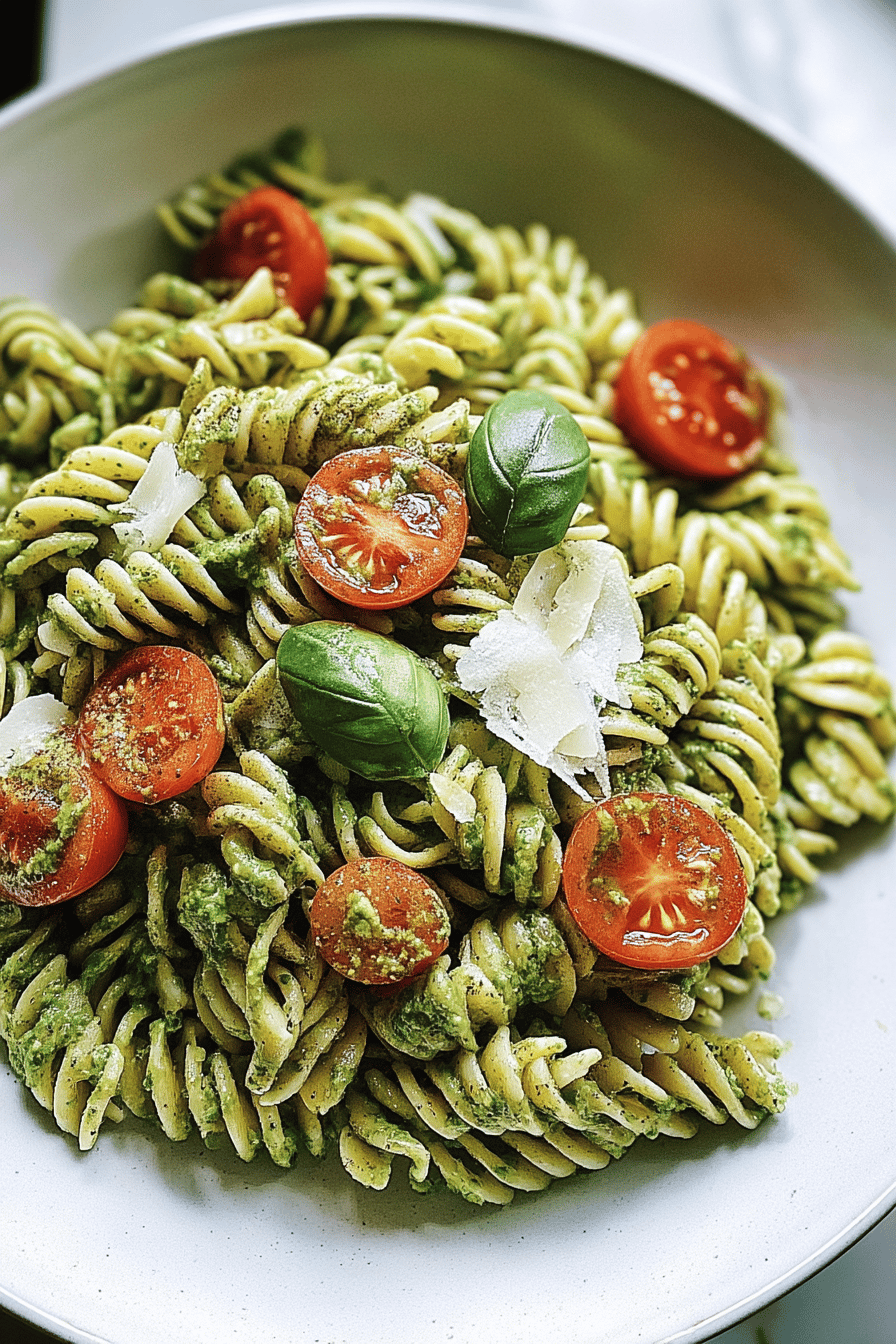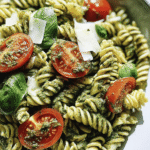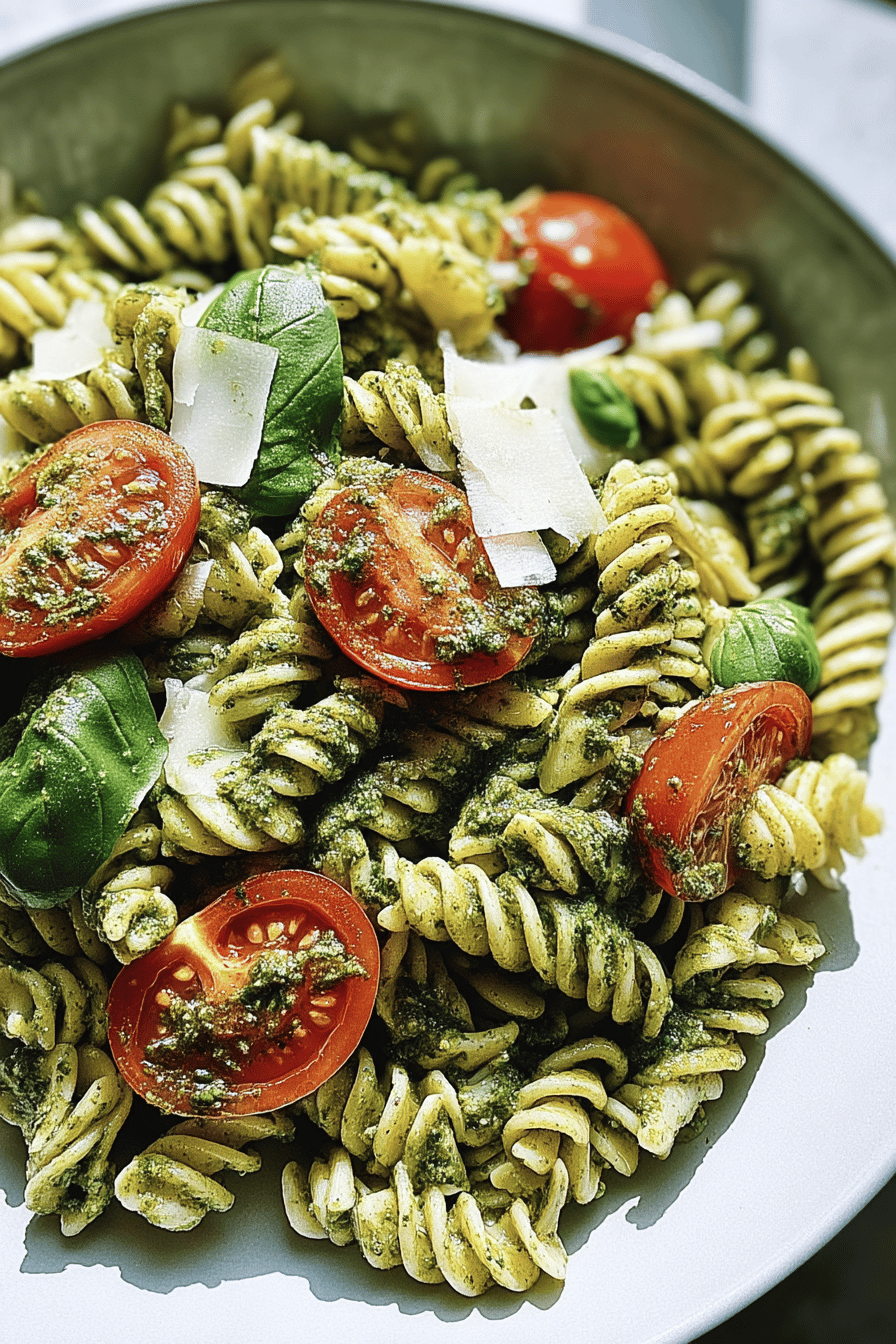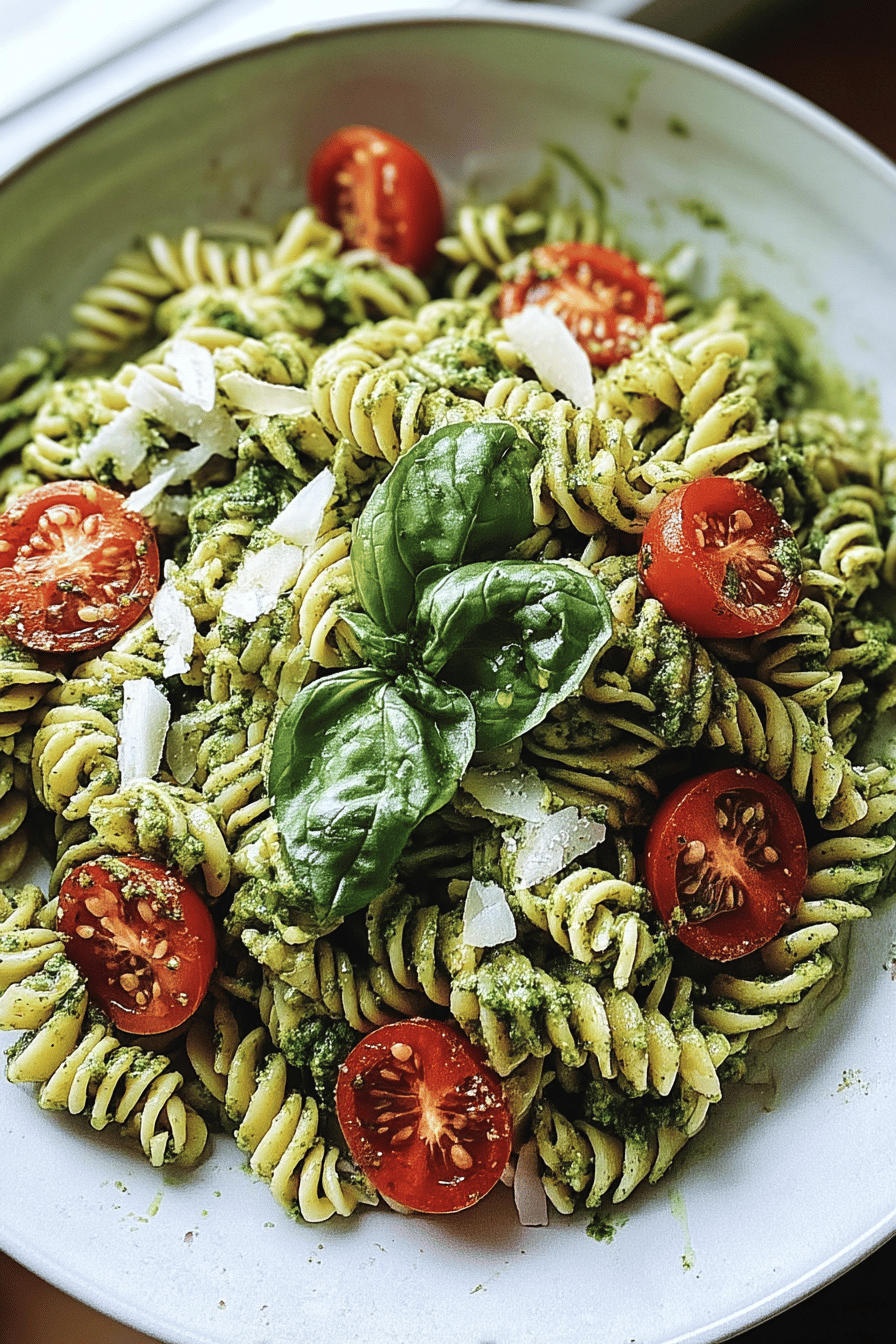Why You’ll Love This Pesto Pasta
This pesto pasta is one of those go-to recipes that never disappoints it’s simple, tasty, and perfect for any meal. Whether you’re cooking for one or a crowd, it brings fresh flavors to the table with minimal effort. Let me break down why it’s such a smart pick for your kitchen routine.
- Ease of preparation: Pesto pasta comes together in a snap, with prep taking just 15 minutes and cooking wrapping up in 10 minutes for a total time of 25 minutes. The steps are straightforward no fancy tools needed so busy parents or students can have a satisfying meal ready without hassle. It’s all about quick boiling and mixing, making pesto pasta an ideal choice for weeknight dinners that feel effortless yet homemade.
- Health benefits: Packed with fresh basil and olive oil, pesto pasta offers a boost of vitamins and healthy fats that support heart health and energy levels. Each serving delivers key nutrients like antioxidants from basil and good fats from olive oil, while the pasta provides carbs for lasting fuel great for diet-conscious folks looking for a balanced dish. Plus, adding veggies or nuts in the pesto keeps it light and nutritious without sacrificing flavor.
- Versatility: This pesto pasta adapts easily to various dietary needs, like swapping regular pasta for gluten-free options or using vegan cheese to keep it plant-based. Travelers or newlyweds can tweak portions for quick meals, and it’s flexible enough for seniors or working professionals to add proteins like chicken or veggies. That means pesto pasta works for everything from a simple side to a full meal, fitting right into your lifestyle.
- Distinctive flavor: What sets pesto pasta apart is its vibrant, herby taste from fresh basil and garlic, creating a fresh and zesty dish that’s hard to beat. The creamy pesto coats each noodle perfectly, offering a burst of Italian-inspired goodness that feels special yet simple. Whether you’re enjoying it on its own or mixing in extras, pesto pasta stands out with its bright flavors that make every bite memorable.
In short, pesto pasta is a reliable favorite for its speed, nutrition, adaptability, and taste once you try it, you’ll see why it’s a staple!
Jump To
- 1. Why You’ll Love This Pesto Pasta
- 2. Essential Ingredients for Pesto Pasta
- 3. How to Prepare the Perfect Pesto Pasta: Step-by-Step Guide
- 4. Dietary Substitutions to Customize Your Pesto Pasta
- 5. Mastering Pesto Pasta: Advanced Tips and Variations
- 6. How to Store Pesto Pasta: Best Practices
- 7. FAQs: Frequently Asked Questions About Pesto Pasta
- 8. pesto pasta
Essential Ingredients for Pesto Pasta
Picking the right ingredients is key to making a delicious pesto pasta, and I’ve got them all lined up for you. This section lists everything with exact measurements and why they matter, so you can create a dish that’s full of flavor and easy to customize.
Main Ingredients
- 1 recipe homemade pesto (prepared with one-third cup olive oil) – Forms the heart of the dish, providing a fresh, herby base that coats the pasta beautifully and infuses it with rich flavors.
- 300 to 350 grams or 10 to 12 ounces pasta of choice such as ziti, penne, or spaghetti – Serves as the main structure, delivering a satisfying chew and helping to absorb the pesto for that perfect pesto pasta experience.
- 2 teaspoons salt – Seasons the pasta water, ensuring the noodles taste great on their own and pair well with the pesto sauce.
- 3/4 cup pasta cooking water (with up to 1 cup reserved for adjusting consistency) – Acts as a natural thickener, making the sauce silky and helping it cling to the pasta without clumping.
- Freshly grated Parmesan for serving – Adds a salty, nutty finish that elevates the dish, offering a classic touch to your pesto pasta.
- Fresh basil leaves for garnish (amount not specified) – Brings extra freshness and color, enhancing the overall appeal of the pesto pasta with a simple sprinkle.
- Sea salt and freshly ground black pepper to taste – Allows for final seasoning adjustments, balancing flavors and making each bowl of pesto pasta just right.
Special Dietary Options
- Vegan: Swap Parmesan for a plant-based version and ensure the pesto uses nutritional yeast instead of cheese to keep your pesto pasta fully vegan and just as creamy.
- Gluten-free: Choose gluten-free pasta options like rice or quinoa varieties to make the pesto pasta safe and tasty for gluten-sensitive eaters without changing the fun.
- Low-calorie: Lighten it up by using less olive oil in the pesto or adding more veggies to the mix, helping keep calories in check while enjoying pesto pasta’s fresh vibes.
How to Prepare the Perfect Pesto Pasta: Step-by-Step Guide
Making pesto pasta is one of those rewarding kitchen tasks that’s quick and straightforward total time is just 25 minutes, with 15 minutes prep and 10 minutes cooking. This guide walks you through each step with clear instructions, including tips for adapting to dietary preferences like vegan swaps or gluten-free options. Let’s get started so youProcessor can enjoy a fresh, flavorful meal in no time!
First Step: Gather and Prep Your Ingredients
Start by pulling together all your ingredients and setting aside about 15 minutes for prep this keeps everything smooth and organized. Measure out 300 toplane 350 grams of pasta like penne or spaghetti, and prepare your homemade pesto using one-third cup olive oil for that fresh basil punch. For dietary tweaks, if you’re going vegan, swap in nutritional yeast for Parmesan, and opt for gluten-free pasta if needed chop any extras like basil leaves for garnish so they’re ready when you are.
Second Step: Boil the Pasta
Bring a large pot of water to a boil and add 2 teaspoons of salt to season it well, which takes about 5 to 7 minutes on high heat. Once boiling, add your 300 to 350 grams of pasta and cook according to the package instructions until al dente, roughly 8 to 10 minutes. Just before draining, scoop out and reserve up to 1 cup of the pasta cooking water this starchy liquid helps create a creamy sauce and makes your pesto pasta come together perfectly. For low-calorie versions, stick to whole-grain pasta to add more fiber without much extra effort.
Third Step: Drain and Reserve Water
Drain the pasta in a colander and let it sit for a minute to remove excess water, but don’t rinse it keeping that starchy coating helps the sauce stick better. Make sure you’ve reserved 3/4 cup to 1 cup of the cooking water as noted, which is key for adjusting the sauce’s consistency later. If you’re adapting for a heartier meal, this is a good spot to toss in veggies like spinach for added nutrition, keeping the pesto pasta light and versatile for different tastes.
Fourth Step: Combine Pasta and Pesto
Transfer the drained pasta to a large bowl or skillet, then add your homemade pesto and start with 1/2 to 3/4 cup of the reserved pasta water. Toss everything together to coat the pasta evenly, adding more water as needed to get that silky, saucy texture this step takes about 2 to 3 minutes over low heat if you’re warming it slightly. Taste and season with sea salt and freshly ground black pepper to taste, and for vegan preferences, double-check that your pesto is plant-based to maintain that creamy goodness in your pesto pasta.
Fifth Step: Garnish and Adjust
Once tossed, give it a quick stir to make sure the pesto pasta is evenly mixed, adjusting with more seasoning or water if it feels too thick or bland. For extra flavor, mix in a squeeze of lemon juice here if you like, and consider adding proteins like grilled chicken for a fuller meal. This keeps the dish adaptable, so if you’re watching calories, hold back on extras and focus on the fresh basil and pesto for a lighter twist.
Final Step: Finishing Touches and Serving
Serve the pesto pasta immediately, garnished with freshly grated Parmesan and fresh basil leaves for that final pop of flavor and color it’s ready in under 5 minutes for plating! This yields about 4 servings, perfect for family meals, and you can portion it out for busy days. Remember, if you’re making it gluten-free, use the right pasta and enjoy how pesto pasta turns into a customizable favorite that’s as fun to eat as it is to make.
This step-by-step approach ensures your pesto pasta is not only delicious but also easy to tailor, making it a hit for everyone at the table.
Dietary Substitutions to Customize Your Pesto Pasta
Protein and Main Component Alternatives
For the main elements in pesto pasta, swap out proteins to fit your needs add grilled chicken or shrimp for a heartier version if you’re looking for more substance. If nuts in the pesto are an issue, try using seeds like pumpkin for a similar crunchy texture, keeping the dish light and adaptable. These changes make pesto pasta easy to adjust based on what’s in your kitchen or dietary preferences.
Vegetable, Sauce, and Seasoning Modifications
Mix in veggies like spinach or cherry tomatoes to boost nutrition and color in your pesto pasta, especially when seasons change. For the sauce, opt for a basil-free pesto if basil is out, or tone down seasonings with less garlic for milder tastes gluten-free options work well here too. This flexibility lets you create a pesto pasta that’s perfect for any occasion or restriction.
Mastering Pesto Pasta: Advanced Tips and Variations
Taking your pesto pasta to the next level means trying a few expert tricks and fun twists what a great way to keep things exciting!
Pro Cooking Techniques
To get the best results, save that pasta water for thinning the sauce and toss in a skillet for even coating, which keeps the pesto from separating. Using fresh ingredients like basil helps lock in flavors, and for a smoother mix, blend the pesto just before adding it to the pasta.
Flavor Variations
Play with seasonings by mixing in sun-dried tomatoes or red pepper flakes for a spicy kick, turning your pesto pasta into something new each time. For more ideas, swing by a garlic parmesan chicken recipe to see how to blend herbs and proteins for added variety.
Presentation Tips
Make it look amazing by topping with fresh basil and a sprinkle of cheese, arranging portions in bowls for a neat, inviting serve. A simple garnish like lemon wedges adds that extra touch to your pesto pasta.
Make-Ahead Options
Prep the pesto ahead and store it for quick meals, or cook the pasta fresh when needed to avoid sogginess it’s perfect for busy schedules and meal prep days.
How to Store Pesto Pasta: Best Practices
Keeping your pesto pasta fresh is simple with the right storage tricks, so let’s cover the basics for short-term and long-term needs.
| Storage Method | Details |
|---|---|
| Refrigeration | Store pesto pasta in an airtight container for up to 2-3 days to keep it fresh, separating sauce from noodles if possible to hold the flavors. |
| Freezing | For longer storage, freeze in portions for up to a month, making it easy to thaw and reheat your pesto pasta when you’re in a rush. |
| Reheating | Reheat gently on the stove with a bit of water to maintain creaminess, ensuring your pesto pasta stays tasty and safe to eat. |
| Meal Prep Considerations | Batch cook and portion for the week, storing in fridge-friendly containers so pesto pasta is ready for quick, homemade meals anytime. |

FAQs: Frequently Asked Questions About Pesto Pasta
What ingredients do I need to make classic pesto pasta?
To prepare classic pesto pasta, you’ll need fresh basil leaves, pine nuts, garlic, grated Parmesan cheese, extra virgin olive oil, salt, and your choice of pasta (typically spaghetti, penne, or linguine). Blend the basil, pine nuts, and garlic while slowly adding olive oil until smooth, then mix in Parmesan cheese. Toss the cooked pasta with the pesto and serve immediately. This simple combination creates a flavorful and aromatic dish.
Can I store leftover pesto pasta, and how should I reheat it?
Yes, leftover pesto pasta can be stored in an airtight container in the refrigerator for up to 2-3 days. To reheat, place the pasta in a pan over low heat, adding a splash of water or olive oil to loosen the sauce and prevent it from drying out. Stir gently until warmed through. Avoid microwaving to maintain the fresh taste and texture of the pesto.
What are some easy variations of pesto pasta to try?
You can vary pesto pasta by using different nuts such as walnuts or almonds instead of pine nuts. Adding vegetables like cherry tomatoes, roasted zucchini, or sautéed mushrooms adds color and nutrition. For a protein boost, include grilled chicken, shrimp, or tofu. Additionally, swapping Parmesan for Pecorino Romano cheese gives a sharper flavor. These tweaks keep the dish fresh and cater to dietary preferences.
Is it possible to make pesto pasta without nuts for allergies?
Absolutely. To make nut-free pesto pasta, substitute pine nuts with seeds such as sunflower or pumpkin seeds, which still provide a creamy texture. Alternatively, you can omit nuts entirely and focus on blending basil, garlic, Parmesan cheese, olive oil, and lemon juice for brightness. This version remains vibrant and tasty while being safe for those with nut allergies.
How long does homemade pesto last, and what is the best way to store it?
Homemade pesto can be stored in the refrigerator for up to one week if kept in an airtight container. To prevent oxidation and browning, pour a thin layer of olive oil on top before sealing. For longer storage, pesto can be frozen in ice cube trays and transferred to a freezer bag, lasting up to 3 months. Thaw frozen pesto in the refrigerator before mixing it with pasta.

pesto pasta
- Total Time: 25 minutes
- Yield: 4 servings
- Diet: Vegetarian
Description
🌿 Enjoy a fresh and vibrant Pesto Pasta dish that is simple to prepare and packed with juicy, herbal flavors.
🍝 This recipe offers a quick, satisfying meal perfect for any pasta lover seeking an easy yet delicious twist.
Ingredients
– 1 recipe homemade pesto (prepared with one-third cup olive oil) Forms the heart of the dish, providing a fresh, herby base that coats the pasta beautifully and infuses it with rich flavors.
– 300 to 350 grams or 10 to 12 ounces pasta of choice such as ziti, penne, or spaghetti Serves as the main structure, delivering a satisfying chew and helping to absorb the pesto for that perfect pesto pasta experience.
– 2 teaspoons salt Seasons the pasta water, ensuring the noodles taste great on their own and pair well with the pesto sauce.
– 3/4 cup pasta cooking water (with up to 1 cup reserved for adjusting consistency) Acts as a natural thickener, making the sauce silky and helping it cling to the pasta without clumping.
– Freshly grated Parmesan for serving Adds a salty, nutty finish that elevates the dish, offering a classic touch to your pesto pasta.
– Fresh basil leaves for garnish Brings extra freshness and color, enhancing the overall appeal of the pesto pasta with a simple sprinkle.
– Sea salt and freshly ground black pepper to taste Allows for final seasoning adjustments, balancing flavors and making each bowl of pesto pasta just right.
Instructions
First Step: Gather and Prep Your Ingredients Start by pulling together all your ingredients and setting aside about 15 minutes for prep this keeps everything smooth and organized. Measure out 300 toplane 350 grams of pasta like penne or spaghetti, and prepare your homemade pesto using one-third cup olive oil for that fresh basil punch. For dietary tweaks, if you’re going vegan, swap in nutritional yeast for Parmesan, and opt for gluten-free pasta if needed chop any extras like basil leaves for garnish so they’re ready when you are.
Second Step: Boil the Pasta Bring a large pot of water to a boil and add 2 teaspoons of salt to season it well, which takes about 5 to 7 minutes on high heat. Once boiling, add your 300 to 350 grams of pasta and cook according to the package instructions until al dente, roughly 8 to 10 minutes. Just before draining, scoop out and reserve up to 1 cup of the pasta cooking water this starchy liquid helps create a creamy sauce and makes your pesto pasta come together perfectly. For low-calorie versions, stick to whole-grain pasta to add more fiber without much extra effort.
Third Step: Drain and Reserve Water Drain the pasta in a colander and let it sit for a minute to remove excess water, but don’t rinse it keeping that starchy coating helps the sauce stick better. Make sure you’ve reserved 3/4 cup to 1 cup of the cooking water as noted, which is key for adjusting the sauce’s consistency later. If you’re adapting for a heartier meal, this is a good spot to toss in veggies like spinach for added nutrition, keeping the pesto pasta light and versatile for different tastes.
Fourth Step: Combine Pasta and Pesto Transfer the drained pasta to a large bowl or skillet, then add your homemade pesto and start with 1/2 to 3/4 cup of the reserved pasta water. Toss everything together to coat the pasta evenly, adding more water as needed to get that silky, saucy texture this step takes about 2 to 3 minutes over low heat if you’re warming it slightly. Taste and season with sea salt and freshly ground black pepper to taste, and for vegan preferences, double-check that your pesto is plant-based to maintain that creamy goodness in your pesto pasta.
Fifth Step: Garnish and Adjust Once tossed, give it a quick stir to make sure the pesto pasta is evenly mixed, adjusting with more seasoning or water if it feels too thick or bland. For extra flavor, mix in a squeeze of lemon juice here if you like, and consider adding proteins like grilled chicken for a fuller meal. This keeps the dish adaptable, so if you’re watching calories, hold back on extras and focus on the fresh basil and pesto for a lighter twist.
Final Step: Finishing Touches and Serving Serve the pesto pasta immediately, garnished with freshly grated Parmesan and fresh basil leaves for that final pop of flavor and color it’s ready in under 5 minutes for plating! This yields about 4 servings, perfect for family meals, and you can portion it out for busy days. Remember, if you’re making it gluten-free, use the right pasta and enjoy how pesto pasta turns into a customizable favorite that’s as fun to eat as it is to make.
Notes
🌿 Toss pasta in a bowl or skillet instead of the pot to keep basil from turning black.
💧 Always reserve pasta cooking water to get the perfect sauce texture.
🍋 Add a squeeze of lemon juice for a bright, fresh flavor boost.
- Prep Time: 15 minutes
- Cook Time: 10 minutes
- Category: Main Course
- Method: Boiling, Tossing
- Cuisine: Italian
Nutrition
- Serving Size: 1 serving
Keywords: pesto, pasta, simple, juicy


